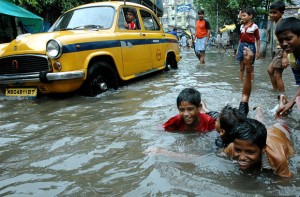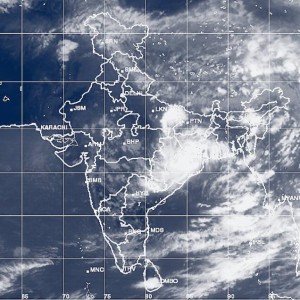In July 2010, heavy rains flooded almost a fifth of Pakistan, killing more than 1,700 people and disrupting the lives of 20 million more. In June 2013, another set of monsoon rains hit Uttarakhand in northern India, flooding 12 of 13 districts in the state and killing at least 5,700. Both of these tragedies can be attributed to medium-intensity versions of a cyclone, a kind of storm known as a monsoon depression.
Monsoons are large weather patterns that occur during the summer season on a continental scale and that give rise to many storms of smaller size with varying strength. The most destructive of these synoptic scale storms are called tropical cyclones — typhoons and hurricanes — while the least destructive are termed monsoon lows. Mid-size storms are the monsoon depressions — they generate about as much rain as a cyclone would, but come with lower wind speeds. Dr. William Boos, a geology and geophysics professor at Yale, noted that the monsoon system in South Asia produces many of these monsoon depressions annually, which bring about a sixth of South Asia’s total rainfall each year. Needless to say, much of agriculture and economy in South Asia hinges on the consistency of monsoon depressions.
But recent studies show a 50 percent decrease in the occurrence of monsoon depressions over South Asia in the last 30 years, a phenomenon that could have a dramatic impact on more than a billion people. This trend seemed drastic, and some meteorologists even claimed that there have been no monsoon depressions in recent years. Then, this past year, Dr. Naftali Cohen, a post-doctoral fellow in Boos’s lab, found flaws in these scientists’ data. The conflicting data coming from Yale suggests that monsoon depressions are not on the decline, after all.
Most importantly, Cohen and Boos have exposed how little we really know about monsoon depressions and their recent patterns. Questions remain because these storms have not received adequate attention from the research community, which Cohen and Boos consider a disgrace. These storms have evaded widespread scientific study for years, despite the fact that their effects warrant a good amount more scientific exploration.
Evading records: history of monsoon depressions
The monsoon season involves a delicate balance of destruction and regeneration. With monsoons come large amounts of water that replenish huge swaths of tropical land, allowing agriculture to flourish. Storms that are too mild leave fields and paddies dry. Of course an overabundance of rainfall could be equally disastrous. In 1864, a tropical cyclone ravaged Calcutta, with floods and other elements of nature killing about 60,000 people. Just two years later, a relatively light monsoon season led to widespread famine.

To avoid such calamities, the British government established the India Meteorological Department (IMD) in 1875. Ever since, the IMD has been collecting data about the South Asian monsoon system, at first recording data by hand from telegrams of weather balloon observations, and more recently from sources like their own satellite system INSAT. For years, studies have been referencing the IMD dataset, one of the only observational sources of monsoon depression information in the world.
In the past decade or so, people have been pointing out patterns in the monsoon depression data from the IMD. More specifically, these studies noted that the IMD data showed a 50 percent decrease in monsoon depression frequency. In addition to this trend, the dataset revealed that 2002, 2010, and 2012 were the first years on record — in more than 100 years — to have no recorded monsoon depressions throughout the entire season. This downward trend is thought to be a potential consequence of global warming, adding to the complex issues associated with climate change.
Cohen and Boos explored the trend together using a special algorithm developed for previous research. By analyzing wind speed and pressure anomalies, Cohen and Boos scanned through years of collected data and made a count of monsoon depressions. Surprisingly, the counts revealed the occurrence of several monsoon depressions in 2002, 2010, and 2012, a finding that directly contradicted the IMD data. “We found at least eight,” Cohen affirmed. If the IMD dataset was missing these counts, then might it have missed monsoon depressions during other years, too?
To confirm their results, the Yale researchers looked at other tracking algorithms as well. One from New York University (NYU) Abu Dhabi, which relies only on pressure anomalies, also observed depressions in those three years. Neither the Yale dataset nor the NYU Abu Dhabi dataset reflected a significant decrease in the frequency of monsoon depressions, which suggests flaws in the IMD dataset. Cohen and Boos produced yet another dataset based on different criteria for describing a storm’s energy, and this dataset also agreed with the others: The IMD dataset was missing a significant number of monsoon depression counts.
Clouded data and clearing the storm
There are several credible reasons as to why the IMD dataset is not the most reliable. Foremost, a large portion of the data collected before the 1920s was done by hand from surface and weather balloon observations, the accuracy of which pales in comparison to modern, high-tech methods. While earlier observations were reasonably good, one can imagine that the techniques and models used have changed — and likely improved — over the years. Cohen and Boos suggest that this inconsistency in metrics may be responsible for trends seen in the data. “It’s a dataset that has existed since the late 1800s, and you can imagine that the observations on which it was based have changed over time,” Boos said.
Boos added that the problem is not specific to the IMD. Rather, the issue with data accuracy may be a consequence of the general disconnect between those who know the science and those who collect the data. “We often want to study 50- or 100-year trends in things like storm counts, temperatures, and rainfall, but over such long periods the instruments used to collect data change and even the criteria for what constitutes a storm might change from one generation to the next,” Boos said. ” Sometimes the people counting storms aren’t thinking about data calibration from one decade to the next. Their job is to get a weather forecast out for the next few days.”
But the point that Cohen and Boos want to emphasize the most is that the minimal scientific attention given to these storms does not reflect the influence that these monsoon depressions have on a large fraction of Earth’s surface. The Yale study utilizes several algorithms and techniques used to count monsoon depressions. While these various methods did agree on the lack of a significant trend and on the consistent presence of summer monsoon depressions, they did not necessarily agree with each other. Hopefully, with more scientific studies and funding, these monsoon depressions will become more transparent. “We hope that [our] paper will focus more attention to these storms that have a large impact yet somehow get less attention scientifically and in general,” Cohen said. “There is a need to collect better data to answer our questions.”

Boos also points to both the scientific significance and mystery of these depressions. He believes that studying these depressions will shine new light on various aspects of monsoons and on our general knowledge of how weather phenomena form, travel, and dissipate. “They are different from hurricanes in terms of fluid dynamics and other physics, and we don’t know what is going on,” Boos said.
Despite the exposure of flaws in prior scientific research, Cohen and Boos are optimistic about a future in which we know much more about monsoons and their effects. “Despite the fact that they have a very large impact on large numbers of people, they haven’t been studied very much,” Boos said. “We don’t even really know how many monsoon depressions there are each year, or their tracks.”
With a greater scientific understanding of monsoon storms, perhaps our observational techniques will improve, as will forecasting and preparations in affected areas. With an increase in scientific interest in monsoons and monsoon depressions, the scientific community and the general public alike will together take steps toward better understanding the planet on which we live. Unraveling our complex system of climate dynamics piece by piece is an important goal in a world ever more concerned with climate change.
Cover Image: Periods of intense rainfall can affect large numbers of people, especially in urban centers. Image courtesy of The Hindu.
About the Author: Rain Tsong is a junior in Morse College, majoring in geology & geophysics and focusing on the environment and energy geoscience track. Outside of writing for the Yale Scientific Magazine, Rain helps coordinate the Yale DEMOS program.
Further Reading:
Cohen, Naftali Y., and William R. Boos. “Has the number of Indian summer monsoon depressions decreased over the last 30 years?.” Geophysical Research Letters 41, no. 22 (2014): 7846-7853.
Godbole, Ramesh V. “The composite structure of the monsoon depression.” Tellus 29, no. 1 (1977): 25-40.
Hahn, Douglas G., and Syukuro Manabe. “The role of mountains in the south Asian monsoon circulation.” Journal of the Atmospheric Sciences 32, no. 8 (1975): 1515-1541.
Hurley, John V., and William R. Boos. “A global climatology of monsoon low‐pressure systems.” Quarterly Journal of the Royal Meteorological Society (2014).
Tang, Lingyu, Caiming Shen, Kambiu Liu, and J. T. Overpeck. “Changes in South Asian monsoon: new high-resolution paleoclimatic records from Tibet, China.” Chinese Science Bulletin 45, no. 1 (2000): 87-91.
Turner, Andrew G., and Hariharasubramanian Annamalai. “Climate change and the South Asian summer monsoon.” Nature Climate Change 2, no. 8 (2012): 587-595.
Acknowledgements: The author would like to thank Dr. Naftali Cohen and Professor William Boos for their time, opinions, and enthusiasm regarding the content of this article.
